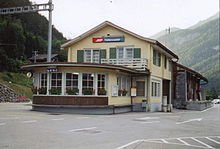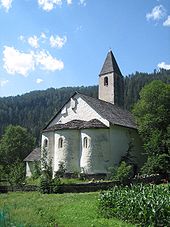 Tiefencastel | ||
| Tiefencastel | ||
| Canton | Grisons | |
|---|---|---|
| Residents | unknown | |
| no value for residents on Wikidata: | ||
| height | 859 m, 1,716 m | |
| no tourist info on Wikidata: | ||
| location | ||
| ||
Tiefencastel is a place in the canton Grisons, Tiefencastel has been part of the political community since a municipal merger Albula / Alvra. It is located at the confluence of the Albula and Julia rivers (Romansh: Gelgia), at the base according to the Julier and des Albula passes and a third pass route, the historically significant one Septimer pass.
background
A traffic junction developed at the Julier and Septimer pass crossings that were already used in Antika. Around 831 Tiefencastel was called Castello Impitinis First mentioned in a document, later the place was called Imo Castello (lowest castle) and in the 14th century. Germanized Tieffenchastl.
Traces of a Bronze Age settlement were found on the Plattas hill, and residues of a Roman fort on the church hill. In the Middle Ages, Tiefencastel was in episcopal ownership and went to the lords of, among others, as a fief Vaz about, in the 16th century the place joined the church association.
In the 6th / 7th Century The Chapel of St. Ambrosius stood on Julierpassstrasse, and in 1343 today's parish church of St. Stefan was mentioned for the first time. After the Reformation, the Counter-Reformation started from the Capuchin Hospice in 1635, the Church of St. Stephen was renovated in 1650/63, the carvings and paintings date from this time.
After a devastating fire in the village in 1890, the connection to the network of the Rhaetian Railway triggered an upswing in 1898, and in 1903 the Albula Railway opened in the Engadin to St. Moritz. The Albula Railway with its viaducts, tunnels and spiral tunnels is part of the UNESCO World Heritage together with the Bernina Railway.
With the opening of the bypass in 1999, the village, which had been burdened by road traffic for a long time, experienced considerable relief from through traffic.
getting there

By plane
Most guests travel via the international airport Zurich![]() (IATA: ZRH) at.
(IATA: ZRH) at.
By train
To travel by public transport, take from Zurich coming here the SBBConnection up Landquart and then climbs onto the red narrow-gauge railway of the Rhaetian Railway over the Albula line St. Moritz around.
over Filisur - Monstein there is also a railway connection through the Landwassertal to Davos.
In the street
Of Zurich or St. Margarethen Coming from the Rhine Valley you can get there on the Autobahn ![]() to Graubünden.
to Graubünden.
One happens Chur, at Reichenau the highway divides ![]() and continues as an expressway Thusis. From there you take road 417 Tiefencastel. From Chur to the Lenzerheide leading main street 3
and continues as an expressway Thusis. From there you take road 417 Tiefencastel. From Chur to the Lenzerheide leading main street 3 ![]() also leads through Tiefencastel and further over the Julier Pass to Silvaplana in the Upper Engadine.
also leads through Tiefencastel and further over the Julier Pass to Silvaplana in the Upper Engadine.
Also the Albula Pass leads over Bergün according to Bevers im Engadine, this pass road is closed in winter from November to June. Thanks to the winter-proof expansion of the more easily passable Julier route serves the Albula Pass mainly for tourist purposes, it is closed to heavy motor vehicles. The 6 km long section from Preda to Bergün is set up as a toboggan run in winter.
mobility
Tourist Attractions


- the catholic 1 Parish Church of St.Stefan comes from the 14th century. and was renewed in the baroque style in 1650/2 and consecrated again in 1660.
- Rail enthusiasts visit the Albula line of the Rhaetian Railway, which was built around 1903 and, with its engineering structures and several spiral tunnels, is a UNESCO World Heritage Site. The most beautiful sections are accessible with footpaths.
- 2 St. Peter Mistail Church The Carolingian Church St. Peter Mistail is considered the best preserved Carolingian three-apse church in Switzerland, it was built around 800 on even older foundations. The nave with the three apses and the Carolingian block altars as well as a few remains of the frescoes date from the Carolingian period, most of the frescoes visible today date from the early 14th century. The flat wooden ceiling was built around 1642.
- An ossuary is attached to the church, and to the south the foundations of a second building from the Carolingian era were found.
- The church can be reached on foot from Tiefencastel.
activities
In summer
- Hikes in Val Tuors or in Oberhalbstein
In the winter
- sledging on the Preda toboggan run - Bergün, the starting point is reached with the Rhaetian Railway. Be careful, you can reach very high speeds on the sled on an icy track and accidents have happened again and again if you don't control the sled!
- Skiing in the ski area Bergün - Filisur or in the ski area Savognin
shop
kitchen
nightlife
accommodation
health
Practical advice
trips
- to the pilgrimage church 1 Visitation of Mary Ziteil: The church, which was renovated in 1849 and 1959 to replace a chapel, commemorates a girl's discovery of the Virgin Mary in 1580; the one above Salouf at 2429 m above sea level. The church built on the flank of Piz Curvér is one of the highest pilgrimage churches in the Eastern Alps and is used by Mon, Salouf or the Cre digl Lai car park can be reached on foot.


